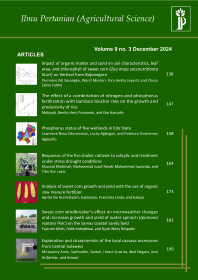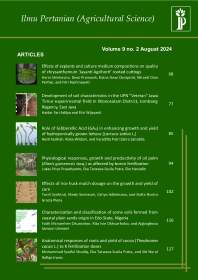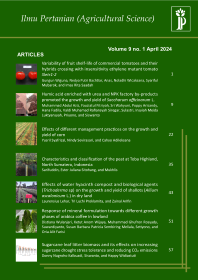The Growth of Two Cultivars Mung Bean under different Sweet Corn Shelter Density in Sandy Soil Coastal Area
Dwi Astutik(1*), Prapto Yudono(2), Sriyanto Waluyo(3)
(1) Department of Agronomy, Faculty of Agriculture, Universitas Gadjah Mada Jln. Flora no. 1, Bulaksumur, Sleman, Yogyakarta 55281, Indonesia
(2) Department of Agronomy, Faculty of Agriculture, Universitas Gadjah Mada Jln. Flora no. 1, Bulaksumur, Sleman, Yogyakarta 55281, Indonesia
(3) Department of Agronomy, Faculty of Agriculture, Universitas Gadjah Mada Jln. Flora no. 1, Bulaksumur, Sleman, Yogyakarta 55281, Indonesia
(*) Corresponding Author
Abstract
Keywords
Full Text:
PDFReferences
Auditya, M. N., S. Trisnowati., and R. Rogomulyo. 2015. Effect of Cow Manure Fertilizer Rates and Weeding Periods on Growth and Yield of Aloe vera (Aloe chinensis B.) and Sesame (Sesamum indicum L.) in Intercropping System in Coastal Sandy Land. Vegetalika Vol. 4 No. 1: 46–55.
Evizal, R., Tohari, I. D. Prijambada, and J. Widada. 2012. The Role of Shade Tree in determining Coffee Yield. J agrotropika 17 (1): 19–23.
Greer, D. H. 2017. Responses of biomass accumulation, photosynthesis and the net carbon budget to high canopy temperatures of Vitis vinifera L. cv. Semillon vines grown in field conditions. Environmental and Experimental Botany. 138 :10–20.
Gurmu, F., Mohammed H, and Alemaw G. 2009. Genotype X environment interactions and stability of soybean for grain yield and Nutrition quality. African Crop Sci J 17: 87–99.
Hayat, S., S.A. Hasan, M. Yusuf, Q. Hayat, and A. Ahmad. 2010. Effect of 28-homobrassinolide on photosynthesis, fluorescence and antioxidant system in the presence or absence of salinity and temperature in Vigna radiata. Environmental and Experimental Botany (69):105–112.
Inayati, A. Dan Marwoto. 2011. Flea control (B. tabaci Genn.) using Combination of Barrier Plants and Chemical Insecticides. Proceedings of Research Results Seminar on Various Beans and Tubers. 279–288.
Mensah, J. K. and J. Ihenyen. 2009. Effects Of Salinity On Germination, Seddling Establishement And Yield Of Three Genotypes Of Mung bean (Vigna Mungo L. Hepper) In Edo State, Nigeria. Nigerian Annals of Natural Sci. 8(2):17–24.
Oliet, J. A and Jacobs, D.F. 2007. Microclimatic Conditions And Plant Morpho-Physiological Development Within A Tree Shelter Environment During Establishment Of Quercus Ilex Seedlings. Agricultural and Forest Meteorology. 144: 58–72.
Parwata, I. G. M. A., D. Indradewa., P. Yudono, B. D. Kertonegoro, and R. Kusmarwiyah. 2014. Growth Responses and Yield of Jatropha (Jatropha curcas L.) to Drought Stress under Coastal Sandy Soil Conditions in The First Year of Production Cycle. J. Agron. Indonesia 42 (1) : 59–65.
Rachman, A., I. G. M. Subiksa, D. Erfandi, and P. Slavich. 2008. Dynamics of tsunami-affected soil properties. P 51-64. In F. Agus and G. Tinning (eds). Proc. of Inter. Workshop on Post Tsunami Soil Management. 180 pp.
Sadeghipour, O. 2009. The Influence Of Water Stress On Biomass And Harvest Indek In Three Mung Bean (Vigna Radiate (L) R. Wilczek) Cultivars. Asian journal of plant sciences 8 (3): 245–249.
Sudyastuti, T. dan Setyawan, N. 2007. Thermal Sandy Coastal Soil With Soil Conditioning and Biomycro In Chili Cultivation (Capsicum annuum L.). Agritech Vo; 27 No. 3: 137–146.
Taufiq, A. dan R. D. Purwaningrahayu. 2013. Mung Bean Cultivar Response to Salinity stress. Agricultural Research of Food Crops. Vol 32. No. 3: 159–170.
Widayat, W. and D. J. Rayati. 2011. Effect of Tree shelter on Tea Plant Leads To Micro Climate, Pest Population, Natural Enemies And The Production Of Tea Shoots. Center for Tea and Kina Gambung Research.
Widodo, A. S. 2015. Effect of Water Irrigation System and Windbreak Plants on production of Onion farming risk in Bantul Regency. Proceedings of agricultural research results seminar. Faculty of agriculture Gadjah Mada University. Yogyakarta.
Yusuf, M.F.B., P. Yudono, and S. Purwanti. 2015. Effect of Organic Mulch on Growth and Seed Results of Three Mung Bean Cultivars (Vigna Radiate L. Wiczek) in Coastal Sandy land. Vegetalika Vol. 4 No. 3: 85–97.
Article Metrics
Refbacks
- There are currently no refbacks.
Ilmu Pertanian (Agricultural Science) ISSN 0126-4214 (print), ISSN 2527-7162 (online) is published by Faculty of Agriculture Universitas Gadjah Mada collaboration with Perhimpunan Sarjana Pertanian Indonesia (PISPI) and licensed under a Creative Commons Attribution-ShareAlike 4.0 International License.













